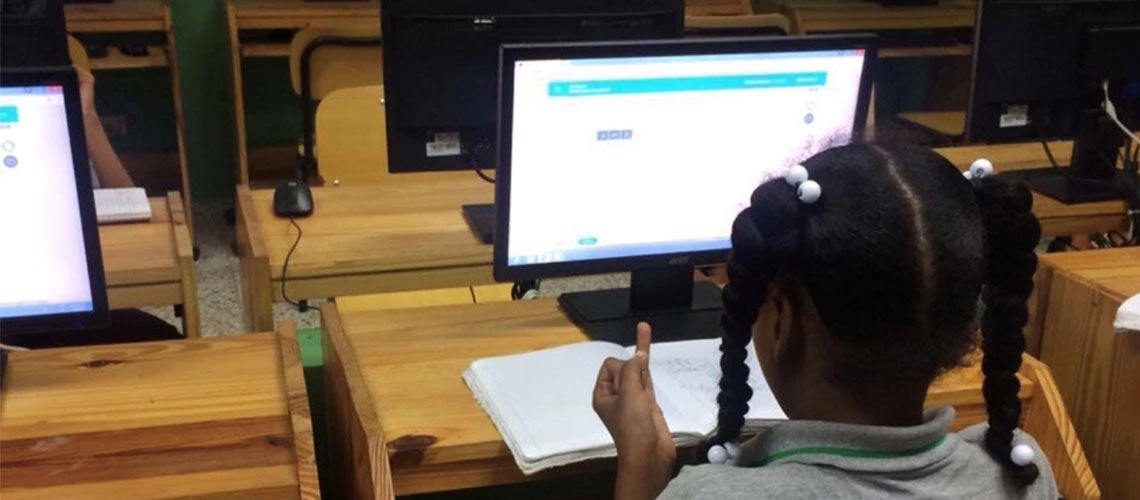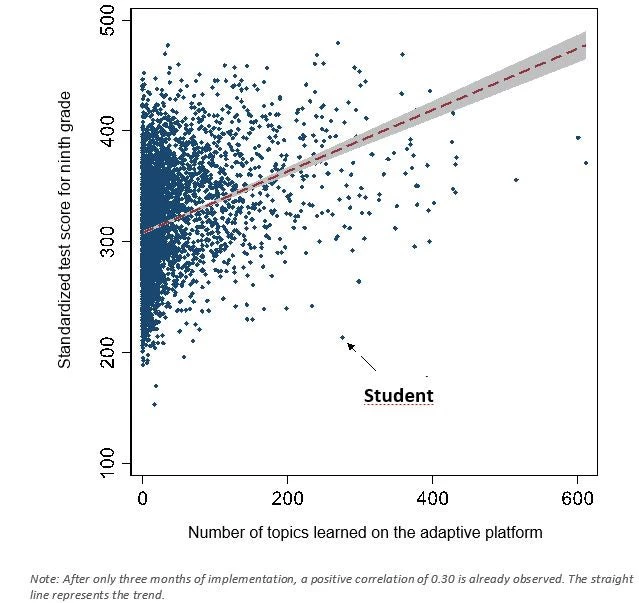 Una estudiante utiliza la plataforma adaptativa de matemáticas durante una de las sesiones de Prográmate en una escuela pública de Santo Domingo, República Dominicana
Una estudiante utiliza la plataforma adaptativa de matemáticas durante una de las sesiones de Prográmate en una escuela pública de Santo Domingo, República Dominicana
Adaptive technology – which adjusts to the level of the user – is a powerful weapon for public education systems to combat learning poverty and one of the best available to teachers. However, little is known about the experience of the educational community in implementing these technologies in public schools.
In 2019, the Ministry of Education in the Dominican Republic (MINERD) with support from the World Bank, launched the Prográmate (In English, Program Yourself) project that uses adaptive technology to improve math learning for students in the third year of secondary school. This technological platform adapts to the level of each student.
Learning on the adaptive platform seems to improve student scores in MINERD's standardized tests

Prográmate reached 50 public schools, equivalent to more than 12,000 high school students. The platform was adapted to the national curriculum and included short training courses for math and computer science teachers as well as pedagogical support to adapt to the learning levels of each student—something that is a significant challenge when serving a large number of students.
Beyond the numbers, listening to users is key to designing programs that are practical and responsive to their needs. In this case, teachers and students shared their experiences through focus groups and structured interviews. Based on their responses, we share three lessons learned:
- Data helps to identify strengths and weaknesses in learning
The platform evaluated students on a continuous basis. If the student was able to correctly answer three exercises in a row on a given topic, they could move on to the next one. If he/she failed in one of the exercises, they returned to previous topics to reinforce them. This made it possible to identify each student's strengths and weaknesses. Knowing this, students would "figure it out" and use other resources – including their teachers, their notebooks, Google, and YouTube videos – to review the topics in which they were lagging. In addition, teachers planned their lessons according to the needs of their students. The platform responded to each student's learning needs.
- Data motivates
With over 600 topics to learn, the platform allowed teachers to monitor their students' progress, and the students to also monitor themselves. Students were motivated to see that they were making progress on a certain number of topics or were only a few topics short of catching up with their peers. In addition, they described the process as "a healthy competition" in which students motivated themselves and each other. The platform also allowed teachers to see how their school was progressing on the platform compared with others. This healthy intra-school competition was revealed as another form of collective motivation.
- Not everything was easy
Some schools faced implementation challenges because they did not have the devices or the internet capacity to connect to the platform. Many of them did not have adequate computers, they were poorly configured, or the platform was not designed to be used on small screens, such as cell phones. Another challenge was the diversity in the level of digital competencies among teachers. To overcome these barriers, students and teachers worked together, collaborating to offer solutions – even during their recess hours – to develop more proficiency on the platform. It was common to find teachers supporting students during their free time, or ministry agents supporting schools.
While an adaptive technology program can be implemented effectively and at scale in public schools, the following adjustments could improve its effectiveness:
- The school community can define some of the parameters of the intervention (where, when, and for how long it is used) based on the reality of the school and experiences in other contexts.
- Define the roles of school and ministry stakeholders and the support they need for implementation.
- Ensure the logistic environment, including the school calendar and parent communication, is conducive to using the platform.
- Provide ongoing support to teachers through a help desk to address implementation challenges.
- Design a data use strategy that aligns with teacher capabilities to have the greatest impact on learning.
Technology as a teacher’s companion, not a replacement
Almost all students said they preferred to learn with the teacher rather than with technology alone. Prográmate demonstrates that teachers and all educational personnel play an essential role in the implementation and learning process.
This school year, MINERD is implementing the adaptive platform for a full year for 5,000 students. The objective is to identify the potential improvement of this technology when implemented for a school year. At the same time, district technicians have standardized support to teachers through different means of communication such as WhatsApp, email, and visits. In six more months, we will know how much this technology can accelerate learning.
Related:
- Blog: Tecnología adaptativa para mejorar el aprendizaje de las matemáticas en República Dominicana (Español)
- Blog: Uso de programas de remediación asistidos por computador para prevenir la deserción estudiantil en el contexto del COVID-19 (Español)
- Podcast: Implementing Adaptive Learning Programs: Lessons from the EdTech Hub
- Podcast: Mitigating Learning Losses and Accelerating Learning through Adaptive Learning: lessons from Ecuador and the Dominican Republic
- Podcast: Implementing Adaptive Learning Programs: Lessons from Whizz Education and Educational Initiatives - Part II
- Podcast: Implementing Adaptive Learning Programs: Lessons from Whizz Education and Educational Initiatives - Part I
- Technologies for Personalized and Adaptive Learning Knowledge Pack




Join the Conversation